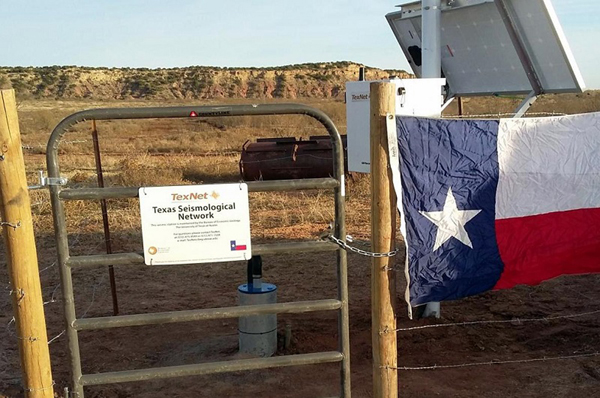- South Texas Students Meet Accordion Music Icons Los Tigres Del Norte In Edinburg Thanks To Khs America/Hohner Alianza Académica Initiative
- Fragile Planet Offers a Nighttime Wildlife Experience
- Falcons Soccer Off & Running
- Cameron County Receives Funds to Improve Two Parks
- Falcons Complete First Half of 32-6A
- School District to Help out Victims of California Wildfires
- Sand Castle Days Continued Despite Unexpected Weather
- Ready for District
- Discussion of Garbage Dumpster Rates, Agreements Between State & City on Highway Regulations, and More
- 31st Annual Shrimp Cook-Off is Right Around the Corner
New Earthquake-Monitoring System Tracks Texas Tremors
- Updated: November 3, 2017

TexNet has set up 22 permanent seismic monitoring stations across the Lone Star State, including this one near Van Horn in West Texas. Photo: Texas Bureau of Economic Geology
by Mark Richardson
AUSTIN, Texas – Many Texans think earthquakes are something they worry about out in California, but Texas officials have just installed a seismic monitoring network to study the frequency and intensity of earthquake activity across the state.
The Texas Bureau of Economic Geology’s TexNet project will pinpoint and analyze the increasing number of tremors, which many believe are caused by oil and gas activity. Texas State Geologist Scott Tinker, director of the bureau, said the need for a statewide network has grown rapidly in the past decade.
“When earthquakes started happening in places where they hadn’t happened before,” he said, “the Legislature, industry and regulators and academics said, ‘Hey, it’d be nice to get in front of these, potentially, and get a network in place, and get some baselines set and study them.’ “
The system has 22 permanent stations and 40 mobile monitors that can be positioned in areas of high activity. When an earthquake occurs in Texas, TexNet will report its strength and location, along with other information. Tinker said Texas quakes, once rare, have increased from about one a year to more than 40 since 2010.
Scott Anderson, senior policy director for the Environmental Defense Fund, said many geologists suspect waste oil injection and fracking at petroleum rigs are the reason for higher numbers of Texas quakes.
“This is also driven indirectly by the experience in Oklahoma, which has had a truly massive increase in earthquakes in the last few years, most of which are believed to be induced by oil and gas activity,” he said.
Compared with Oklahoma or California, which see hundreds of quakes a year – some at magnitude 5 or stronger – the shakers in Texas are mostly just a nuisance, Tinker said.
“So, when you get an earthquake with a magnitude 2.5 or 3.0, which is still kind of relatively large for Texas,” he said, “people wouldn’t even quit reading the paper or having a cocktail in California.”
He said TexNet, the only statewide seismic network in the country, will be studied by researchers at the University of Texas-Austin, Southern Methodist University, Texas A&M and the Southwest Research Institute. The public also can access seismic data and reports from the TexNet website, beg.utexas.edu/texnet.
